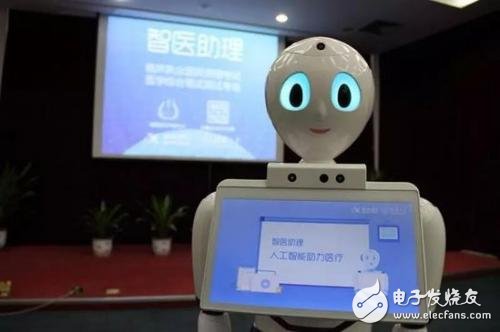Recently, the "Intelligent Assistant" robot from the University of Science and Technology has officially begun its internship in the Fuyang District of Hefei, assisting local general practitioners with daily medical tasks. This marks a significant step in integrating artificial intelligence into primary healthcare, aiming to improve efficiency and accuracy in patient care.
The "Intelligent Assistant" AI-assisted diagnosis system was developed jointly by Keda Xunfei and Tsinghua University. It can quickly generate electronic medical records based on doctor-patient conversations and provide preliminary diagnostic suggestions. After the robot completes the initial assessment, doctors review the findings, access the patient’s medical history through the system, and refer to similar cases, clinical guidelines, and drug information for better decision-making.
According to official reports, the "Intelligent Assistant" is capable of automatically extracting key medical information during doctor-patient interactions and generating structured electronic health records. This not only saves time but also reduces the chances of human error in documentation.
Leveraging advanced cognitive intelligence technologies, the system has been trained on extensive medical resources, including textbooks, clinical guidelines, and case studies. As a result, it can offer differential diagnoses, supporting doctors in making more accurate and timely treatment decisions. This enhances the overall quality of care and improves treatment outcomes.
Additionally, the system is designed to monitor patients with chronic conditions and other high-risk groups. It follows up on scheduled visits set by family doctors, helping track patients’ health status and manage their long-term care. This contributes to more comprehensive and continuous healthcare services for the community.
Notably, the "Intelligent Assistant" robot recently passed the written exam for the National Physician Qualification Examination with a score of 96, exceeding the passing threshold. This achievement highlights its growing capability to support medical professionals in real-world settings.

The success of the "Intelligent Assistant" reflects significant progress in two key areas: knowledge acquisition and application. First, it uses a "multi-semantic deep learning" algorithm to process vast amounts of medical data, building a comprehensive knowledge base covering textbooks, clinical guidelines, and case studies. Second, it employs multi-scale fusion reasoning algorithms, such as "keypoint semantic reasoning" and "evidence chain semantic reasoning," enabling it to analyze complex medical scenarios at multiple levels.
Lu Xiaoliang, deputy general manager of Keda Xunfei Medical, described the new AI-driven diagnostic model as follows: During doctor-patient communication, voice is converted to text, and key information is extracted. This is combined with machine learning and medical imaging capabilities, allowing the system to assist doctors in making informed decisions about diagnosis and treatment.
This model is now being implemented through the "Flying Doctor Assistant" program, demonstrating the practical application of AI in real medical environments.
The University of Science and Technology has made rapid progress in the healthcare sector. In June 2016, Keda Xunfei partnered with Anhui Provincial Hospital to establish the "Medical Artificial Intelligence Joint Laboratory," combining technological innovations with medical expertise for joint research.
A year later, they launched the Anhui Provincial Wisdom Hospital, which integrated with the Anhui Medical Imaging Cloud Platform and the Remote Consultation Platform of the Provincial Hospital. This allowed seamless connectivity across county-level hospitals throughout the province.
The smart hospital has deployed several AI-powered tools, including the intelligent medical guidance robot "Xiao Medicine," AI-based medical image diagnosis systems, voice-to-text electronic medical records, voice assistants for oral and ultrasound exams, and cloud-based mobile medical workstations. These innovations are transforming the way healthcare is delivered, making it more efficient, accurate, and accessible.
Outdoor Drop Cable,Ftth Cables,Fiber Optic Drop Cable,Drop Cable Fiber
Guangzhou Jiqian Fiber Optic Cable Co.,ltd , https://www.jqopticcable.com